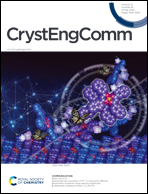The role of surface energy heterogeneity on crystal morphology during solid-state crystallization at the amorphous atazanavir–water interface†
Abstract
Enhancing dissolution of pharmaceutical products via amorphous formulations is a common strategy for improving bioavailability for drugs with low aqueous solubility. Crystallization of the amorphous material during storage as well as from solution during dosing has been well studied and is typically mitigated by the incorporation of polymeric excipients into the amorphous formulation. However, the solid-state crystallization of drug-rich amorphous surfaces upon exposure to a dissolution medium is not as well understood. This study employs experiments and computational modeling to characterize crystallization of amorphous pharmaceutical surfaces exposed to an aqueous environment. Two-dimensional lattice Monte Carlo simulations demonstrate the importance of the surface energy of the underlying film for the morphology of the evolving crystals. Atomic force microscopy topography measurements of the evolving surfaces indicate a non-classical solid-state crystallization mechanism which results in anisotropic needle-like crystals which grow laterally but above the plane of the film, in good agreement with other solid-state crystallization phenomena reported in the literature. These results shed significant light into important factors for predicting and controlling this undesired phase transformation.



 Please wait while we load your content...
Please wait while we load your content...